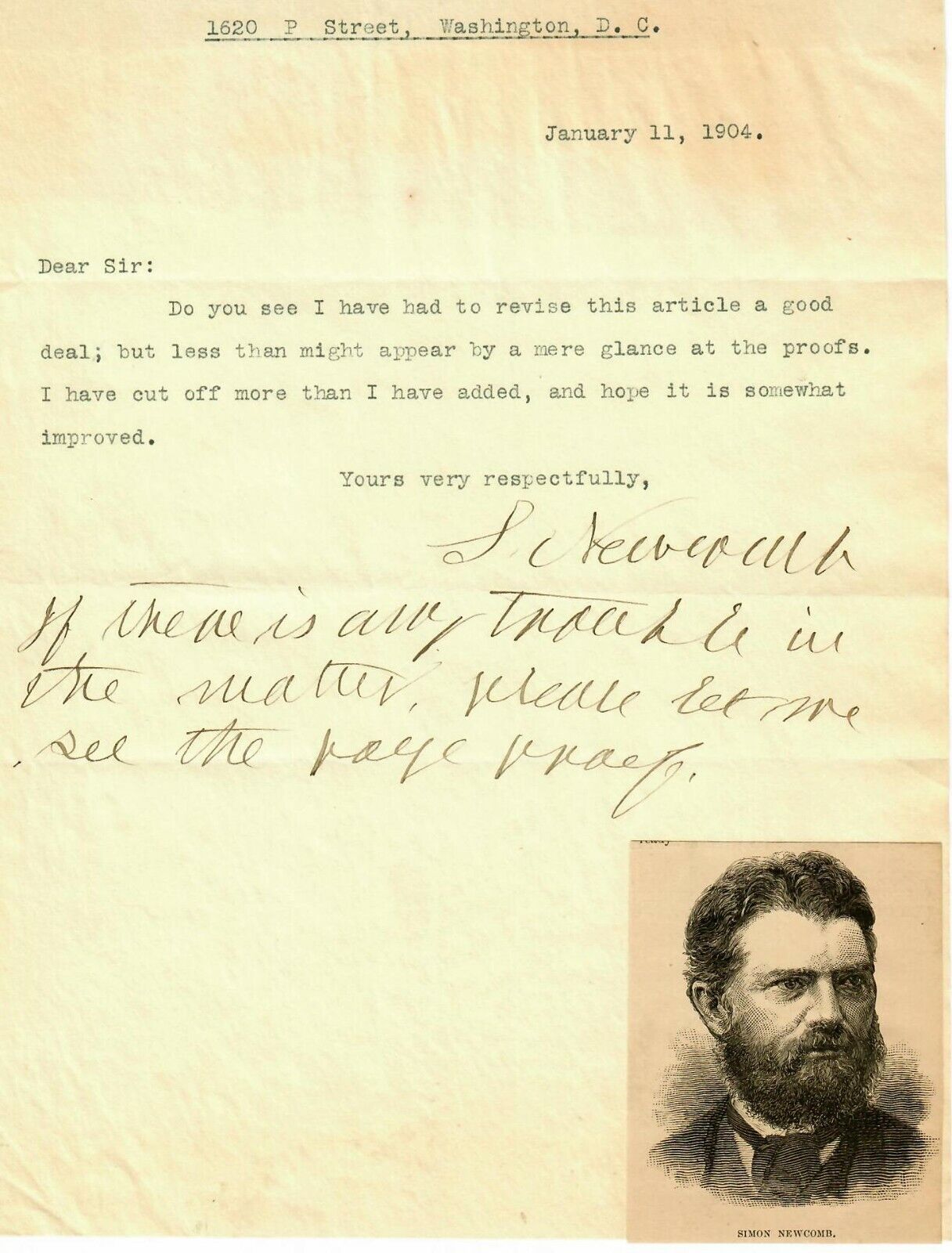-40%
RARE! "Autodidactic Polymath" Simon Newcomb Hand Written Note Todd Mueller COA
$ 258.71
- Description
- Size Guide
Description
Official PayPal Conversion RatesAdd
Currency Converter
To Your Items
Up for auction a
RARE! "Autodidactic Polymath" Simon Newcomb Hand Written Note . This item is certified authentic by Todd Mueller Autographs and comes with their Certificate of Authenticity.
ES-2578
Simon Newcomb
(March 12, 1835 – July 11, 1909) was a
Canadian
–
American
astronomer
,
applied mathematician
and
autodidactic
polymath
, who was Professor of Mathematics in the
United States Navy
and at
Johns Hopkins University
.
Though he had little conventional schooling, he made important contributions to
timekeeping
as well as other fields in
applied mathematics
such as
economics
and
statistics
in addition to writing a
science fiction
novel
. Simon Newcomb was born in the town of
Wallace
,
Nova Scotia
. His parents were Emily Prince, the daughter of a New Brunswick magistrate, and itinerant school teacher John Burton Newcomb. John moved around teaching in different parts of Canada, particularly in different villages in Nova Scotia and
Prince Edward Island
. Emily was a daughter of Thomas Prince and Miriam
Steeves
, making Simon a great-great-grandson of
Heinrich Stief
, and a not-too-distant cousin of
William Henry Steeves
, a Canadian
Father of Confederation
. Newcomb seems to have had little conventional schooling other than from his father and from a short
apprenticeship
to Dr. Foshay, a charlatan
herbalist
, in New Brunswick in 1851. Nevertheless, his father provided him with an excellent foundation for his future studies. Newcomb's apprenticeship with Dr. Foshay occurred when he was 16-years-old. They entered an agreement that Newcomb would serve a five-year apprenticeship during which time Foshay would train him in using herbs to treat illnesses. For two years he was an apprentice but became increasingly unhappy and disillusioned with his apprenticeship and about Foshay's unscientific approach, realizing that the man was a charlatan. He made the decision to walk out on Foshay and break their agreement. He walked the 120 miles (190 km) to the port of Calais in Maine where he met the captain of a ship who agreed to take him to
Salem, Massachusetts
so that he could join his father. In about 1854, he joined his father in Salem (John Newcomb had moved earlier to the United States), and the two journeyed together to Maryland. After arriving in Maryland, Newcomb taught for two years from 1854 to 1856; for the first year in a country school in Massey's Cross Roads,
Kent County, Maryland
, then for a year at a school not far south in
Sudlersville
in
Queen Anne's County, Maryland
. In his spare time he studied a variety of subjects such as political economy and religion, but his deepest studies were made in mathematics and astronomy. In particular he read Newton's
Principia
at this time. In 1856 he took up a position as a private tutor close to Washington and he often travelled to that city to study mathematics in the libraries there. He was able to borrow a copy of
Bowditch's
translation of
Laplace's
Traité de mécanique céleste
from the library of the Smithsonian Institution but found the mathematics beyond him.
Newcomb studied
mathematics
and
physics
privately and supported himself by teaching before becoming a
human computer
(a functionary in charge of calculations) at the
Nautical Almanac Office
in
Cambridge, Massachusetts
in 1857. At around the same time, he enrolled at the
Lawrence Scientific School
of
Harvard University
, graduating
BSc
in 1858.
Newcomb studied mathematics under
Benjamin Peirce
and the impecunious Newcomb was often a welcome guest at the Peirce home. However, he later was said to develop a dislike of Peirce's son,
Charles Sanders Peirce
and has been accused of a "successful destruction" of C. S. Peirce's career.
[5]
In particular,
Daniel Coit Gilman
, president of
Johns Hopkins University
, is alleged to have been on the point of awarding
tenure
to C. S. Peirce, before Newcomb intervened behind the scenes to dissuade him. About 20 years later, Newcomb allegedly influenced the
Carnegie Institution
Trustees
, to prevent C. S. Peirce's last chance to publish his life's work, through a denial of a Carnegie grant to Peirce, even though
Andrew Carnegie
himself,
Theodore Roosevelt
,
William James
and others, wrote to support it. In the prelude to the
American Civil War
, many
US Navy
staff of
Confederate
sympathies left the service and, in 1861, Newcomb took advantage of one of the ensuing vacancies to become professor of
mathematics
and
astronomer
at the
United States Naval Observatory
,
Washington D.C.
. Newcomb set to work on the measurement of the position of the
planets
as an aid to navigation, becoming increasingly interested in theories of
planetary motion
.
By the time Newcomb visited
Paris
, France in 1870, he was already aware that the table of lunar positions calculated by
Peter Andreas Hansen
was in error. While in Paris, he realised that, in addition to the data from 1750 to 1838 that Hansen had used, there was further data stretching as far back as 1672. His visit allowed little serenity for analysis as he witnessed the defeat of French emperor
Napoleon III
in the
Franco-Prussian War
and the coup that ended the
Second French Empire
. Newcomb managed to escape from the city during the ensuing rioting that led up to the formation of the
Paris Commune
and which engulfed the
Paris Observatory
. Newcomb was able to use the "new" data to revise Hansen's tables.
He was offered the post of director of the
Harvard College Observatory
in 1875 but declined, having by now settled that his interests lay in
mathematics
rather than observation.
View more great items










